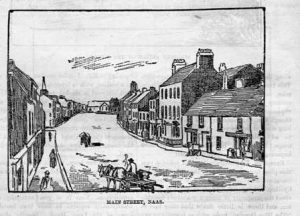Rambles Near Dublin,1890 – No. 16 – Rathcoole, Kill, Naas, Sallins and Straffan
This piece below is taken from Rambles Near Dublin by W. St. J. Joyce. Published as Evening Telegraph Reprints – IX by “Evening Telegraph” Office, 83 Middle Abbey Street, 1890. An original copy is in the Kildare Local Studies Collection in Newbridge.
The County Kildare is not very suitable for pedestrians – the distances as a rule are considerable, and the country rather flat. For pretty pastoral scenery, however, it much excels Dublin, and the entire appearance of the country is richer and more luxuriant. Many wild flowers scarcely to be seen at all near Dublin abound in the county Kildare, and primroses and other spring flowers are often as much as a fortnight earlier. The roads, too, are much better, probably owing to the lighter traffic, and some of them, particularly the by-roads, are extremely pretty…
…From Blackchurch commences the first decided fall in the road since leaving Dublin, and though slight, it is continuous enough to afford easy running to Kill, 3 miles further, a pretty village in a hollow, with a church and chapel. From Kill the road is shaded to Johnstown, 1 ½ miles distant, an inconsiderable hamlet with a large hunting stables. On approaching Naas, which is entered two miles from Johnstown, the road widens somewhat and crosses the new Baltinglass branch of the G.S. and W. Railway, just beside the town. The new station of Naas adjoins the road.
Naas is a fine town, of much better appearance than the average of its size, and possesses a main street with some imposing buildings. On a market day the streets present a most animated appearance. Naas is of great antiquity, and is traditionally reputed to have been founded by Lewy of the Long Hand. Shortly after the English invasion it was fortified and enclosed by a walk and the Irish expelled, so that it must have been even then a place of some importance, as the Irish were not tolerated in any town worth living in. Two remarkable moats, popularly supposed to have been erected by the Danes, still survive, and on the north one the States of Leinster are said to have held their general assemblies. The south moat presents the appearance of a modern mound, and there can be little doubt that original dun of Naas, if it exists, is the north one. On its summit is a building, which served as a guardroom for the old jail. The parish of Naas was formerly called St. David’s, after the patron saint of Wales, who was held in great veneration here. In connection with this matter a curious anecdote is told. In 1798 some Welsh soldiers marching through the town observed a number of inhabitants wearing leeks, and were greatly enraged at this supposed desecration of their national emblem by “rebels” but on finding that their patron saint was also St. David, they became quite friendly and fraternised with the townspeople, to the great embarrassment of the authorities. St. David’s Day was formerly publicly celebrated at Naas; the custom may possibly have originated with a Welsh colony. Within the present parochial church stands the hold water font of the old church of St. David.
About three-quarters of a mile beyond Naas, on the Newbridge road, are the massive and unprepossessing remains of Jigginstown, originally Sigginstown House, commenced by Earl Strafford in the reign of Charles 1., but never finished, as Strafford was summoned to England shortly afterwards, and beheaded. The ruin is popularly known as “The Old Buildings.” The bricks, of which it is entirely built, are said to have been brought from Holland, and are so good that the structure is in as perfect a condition as when its building was suspended 250 years ago. The peasant as he passes the gloomy building execrates the memory of “Black Tom,” as Strafford was known, who was one of the cruelest tyrants of any age, and justly expiated his crimes on the scaffold.
Close to this building is a disreputable-looking ruin bearing the equally disreputable title of Castlerag, of which nothing is known; but it is surmised that the name is a corruption of Castlecrag. A short distance further the road crosses a branch of the canal by Limerick Bridge, which is very steep, and commands a good view of the surrounding flat country. Far back in the distance may be seen the blue outlines of Dublin and Wicklow Mountains, while in front the Chair of Kildare and the Hill of Allen stand prominently in view. For the route described in this article is it unnecessary to proceed beyond Naas, but if time permits it will be worth while to go as far as this bridge and see Jigginstown House.
On returning to the town of Naas, take either the main road to Sallins or the road along the canal, which is a little longer. Sallins formerly consisted of a few cottages, but is growing in size since the construction of the Baltinglass branch railway, which has its junction here. On crossing the bridge at Sallins, turn immediately to the right by the side of the canal, from which the road diverges in a few hundred yards, and then rises sharply for about a quarter of a mile. From the high part here there are beautiful views of the mountains, and of the rich tract lying westward towards the Queen’s County. The road from Sallins to Straffan, about 5 miles long, is beautifully shaded in parts, and excellent for cycling. Straffan consists of some five or six houses; the only one of any importance is the police barracks, a large, handsome structure, built in imposing architectural style. At Straffan Station, now disused, a terrible accident occurred on Sept. 5, 1853 – the express train from Dublin to Cork stopped here, and was run into by a goods train; thirteen persons were killed on the spot, and three died afterwards.

